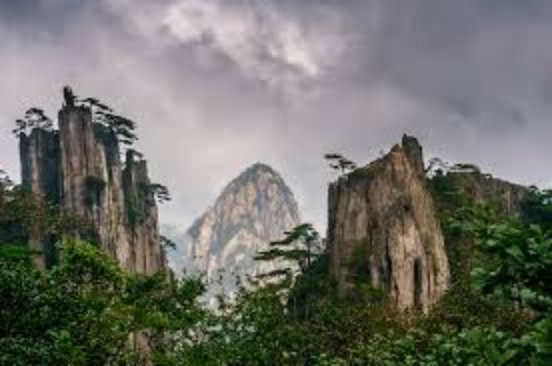
Is Huangshan a top National Park?
Huangshan, literally meaning "Yellow Mountain," is a mountain range in southern Anhui province in eastern China. It's a UNESCO World Heritage Site and one of China's most famous and beloved tourist destinations. The area is well known for its scenery, sunsets, peculiarly-shaped granite peaks, Huangshan pine trees, hot springs, winter snow, and views of the clouds from above. Huangshan is a frequent subject of traditional Chinese paintings and literature, as well as the modern photography.
How High is Huangshan?
Huangshan is a mountain range with peaks reaching a height of 6,115 feet (1,864 m). Huangshan translated “yellow mountain,” showcases the three highest peaks of Lotus Peak, Bright Peak, and Celestial Peak. Lotus is the tallest and represents the highest point in the national park.
Here's a table summarizing the heights of the three main peaks:
| Peak | Height (meters) | Height (feet) |
|---|---|---|
| Lotus Peak (莲花峰) | 1864 | 6115 |
| Bright Summit (光明顶) | 1840 | 6037 |
| Celestial Peak (天都峰) | 1829 | 5997 |
What makes Huangshan special?
Many factors contribute to Huangshan's status as a top national park:
-
Spectacular Scenery: Huangshan is renowned for its breathtaking scenery, characterized by:
- Granite Peaks: The iconic granite peaks, often shrouded in mist, create a surreal and awe-inspiring landscape.
- Huangshan Pine Trees: The uniquely shaped Huangshan pine trees, clinging to the cliffs and rocks, add to the visual drama.
- Hot Springs: Natural hot springs offer relaxation and rejuvenation to visitors.
- Sea of Clouds: The mountain's elevation frequently places it above cloud level, creating a mesmerizing "sea of clouds" effect, especially captivating at sunrise and sunset.
-
Rich History and Culture: Huangshan has been a source of inspiration for artists, poets, and philosophers for centuries. Its connection to Taoism adds a layer of cultural significance. Numerous temples and historical sites dot the mountain paths.
-
Accessibility and Infrastructure: Despite its rugged beauty, Huangshan is well-developed for tourism. Cable cars and well-maintained hiking trails provide access to the summit regions, catering to different fitness levels.
-
Unique Flora and Fauna: The park is home to diverse plant and animal life, some of which are endemic to the region.
What are the drawbacks of visiting Huangshan?
-
Crowds: Huangshan's popularity can lead to large crowds, especially during peak seasons, which may detract from the tranquil atmosphere.
-
Cost: Entrance fees, cable car rides, and accommodation can be relatively expensive.
-
Strenuous Hiking: While accessible by cable car, exploring Huangshan fully involves strenuous hiking, which might not be suitable for everyone.
Is Huangshan a Top National Park?
Without a doubt, Huangshan deserves its place among the top national parks globally. Its unique combination of natural beauty, cultural significance, and accessibility makes it a must-visit destination.
FAQs
1. What is the best time to visit Huangshan?
The best time to visit Huangshan is during the spring (April-May) and autumn (September-October) when the weather is mild and clear. However, each season offers a distinct charm.
2. How long should I spend in Huangshan?
Ideally, plan for at least two full days to explore the main highlights of Huangshan.
3. Is it necessary to hire a guide in Huangshan?
While not mandatory, hiring a guide can enhance your experience by providing local insights, historical context, and navigating the trails.